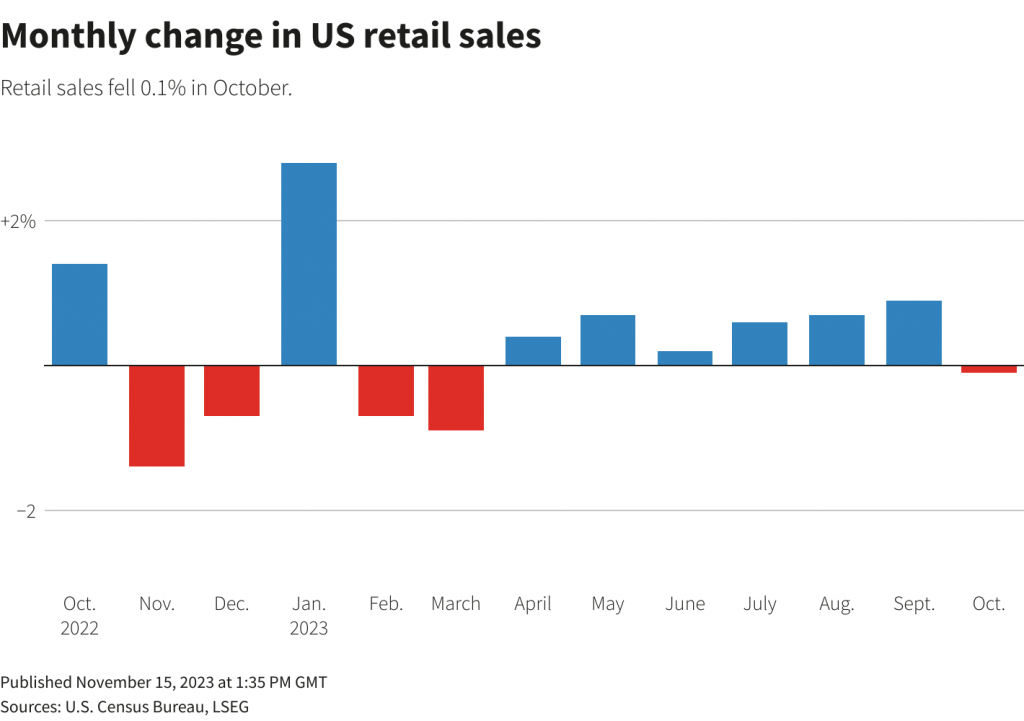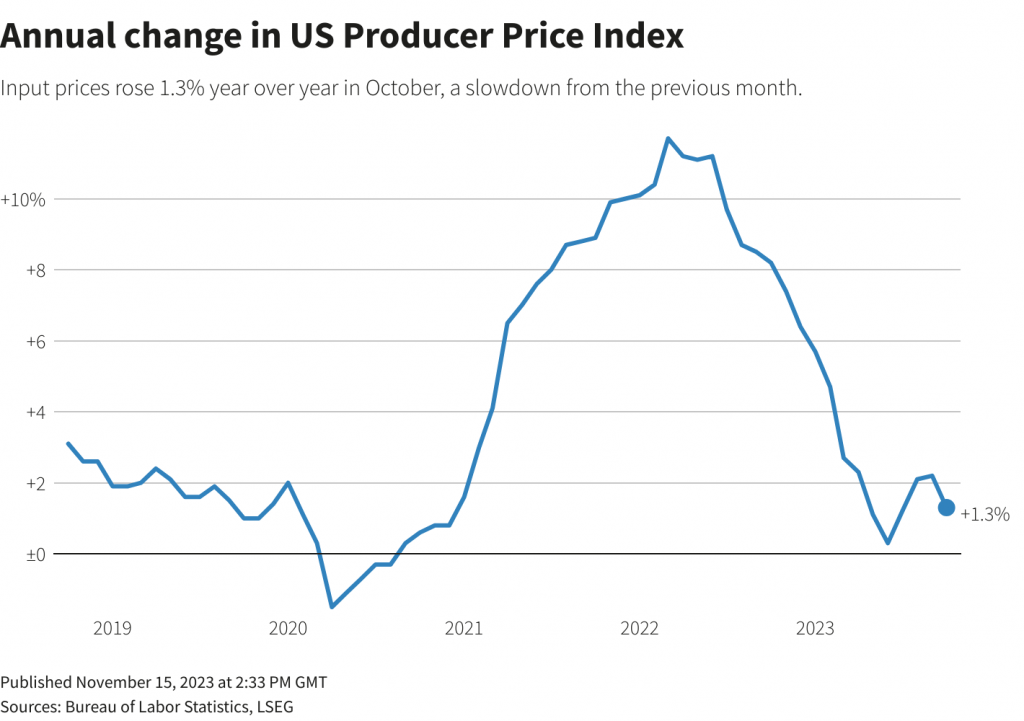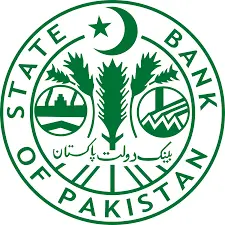Washington November 15 2023: U.S. retail sales fell for the first time in seven months in October as motor vehicle purchases and spending on hobbies dropped, pointing to slowing demand at the start of the fourth quarter that further strengthened expectations the Federal Reserve is done hiking interest rates.
That was supported by other data on Wednesday showing the biggest decline in producer prices in three-and-a-half years in October on the back of cheaper gasoline. The reports followed on the heels of news on Tuesday that consumer prices were unchanged last month for the first time in more than a year.
These data, combined with a cooling labor market, led economists to conclude that the U.S. central bank’s current rate hiking cycle was over. Still, there is no sign that the economy is sliding into recession. The drop in sales in October was less than expected and followed three straight months of hefty gains.
“The economy is returning to a more normal pace of growth and inflation,” said Bill Adams, chief economist at Comerica Bank in Dallas.
Retail sales slipped 0.1% last month, the Commerce Department’s Census Bureau said. Data for September was revised higher to show sales increasing 0.9% instead of the previously reported 0.7% rise. Economists polled by Reuters had forecast retail sales would fall 0.3%.
Retail sales are mostly goods and are not adjusted for inflation. The decline was led by sales of motor vehicles and parts, which fell 1.1%. Economists attributed some of the decrease to the recently ended United Auto Workers strike, which could have limited supply. Furniture store sales dropped 2.0%, while receipts at electronics and appliance outlets rose 0.6%.

There was a 1.7% decline sales at miscellaneous retailers. Receipts at sporting goods, hobby, musical instrument and book stores fell 0.8%. Clothing store sales were unchanged.
Online sales rose 0.2%, showing little boost from Amazon’s (AMZN.O) second Prime Day promotion.
Sales at food services and drinking places, the only services component in the report, gained 0.3%. Economists view dining out as a key indicator of household finances.
Receipts also rose at health and personal care stores as well as food and beverage outlets.
U.S. stocks opened higher, extending the prior session’s strong rally. The dollar rose against a basket of currencies. U.S. Treasury prices fell.
CONSUMER SPENDING COOLING
Financial markets are anticipating an interest rate cut next May, according to CME Group’s FedWatch Tool. Since March 2022, the Fed has raised its benchmark overnight interest rate by 525 basis points to the current 5.25%-5.50% range.
Though some of the dip in retail sales last month was payback after the recent streak of strong growth, it was also a sign that consumers are feeling the heat from higher borrowing costs, with most lower-income families relying on credit cards to fund purchases after exhausting excess savings accumulated during the COVID-19 pandemic.
Excluding automobiles, gasoline, building materials and food services, retail sales rose 0.2% in October. Data for September was revised up to show these so-called core retail sales rising 0.7% instead of the previously reported 0.6%.
Core retail sales correspond most closely with the consumer spending component of GDP. Consumer spending surged in the third quarter, making a significant contribution to the economy’s 4.9% annualized growth pace. The economy grew at a 2.1% rate in the second quarter.
A separate report from the Labor Department’s Bureau of Labor Statistics on Wednesday showed the producer price index for final demand declined 0.5% in October, the largest decrease since April 2020. The PPI rose 0.4% in September.
Economists had forecast the PPI would edge up 0.1%. In the 12 months through October, the PPI increased 1.3% after rising 2.2% in September.

Goods prices dropped 1.4%, with a 15.3 plunge in gasoline prices accounting for more than 80% of the decline. Goods prices rose 0.8% in September. Food prices fell 0.2%.
Excluding the volatile energy and energy components, goods prices edged up 0.1% last month. These so-called core goods prices increased 0.2% in September.
The cost of services was unchanged after increasing 0.2% in the prior month. Airline fares rose 3.1%. There were also increases in the costs of inpatient and outpatient care as well as transportation of freight by road. But portfolio management fees and prices for motel and hotel rooms fell.
Airline fares, portfolio management fees are some of the components that go into the calculation of the personal consumption expenditures price indexes, the inflation measures tracked by the Fed for its 2% target.
The narrower measure of PPI, which strips out food, energy and trade services components, nudged up 0.1% last month after climbing 0.3% in September. The core PPI increased 2.9% on a year-on-year basis in October after rising 3.0% in September.










